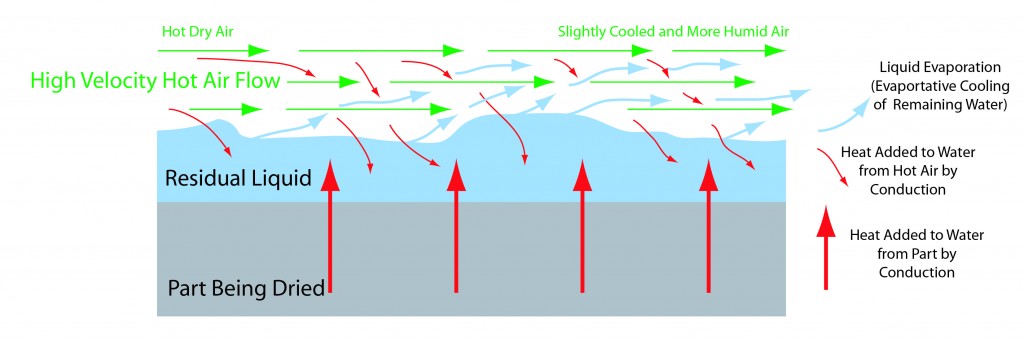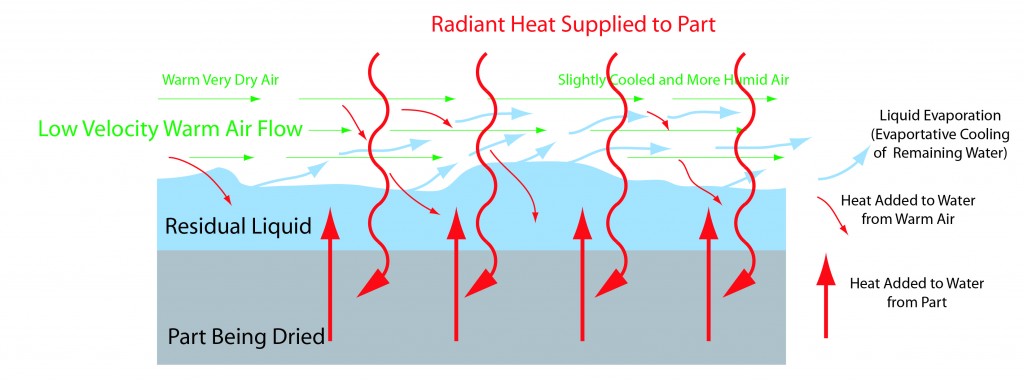In the previous blog, I promised that we would further explore Conductive vs. Radiant heating as a way to dry parts in this blog. I can think of no better way than by using a couple of illustrations showing the flow of heat in both cases.
Hot Air Drying – Conductive

In a hot air dryer, a flow of air is first heated by a heat source such as an electric heater. As we learned earlier, increasing the temperature of the air lowers its relative humidity which accelerates the evaporation of water. The heated, dry air flows over and around the part being dried. Once the hot air encounters the wet part and water starts evaporating from its surface, evaporative cooling lowers the temperature of the remaining water. The cooled water needs to acquire heat to maintain temperature balance. One might first think that the water would be heated by the hot air. In fact, it may be to some degree but, remember, evaporative cooling is still occurring at the air/water interface and this evaporation consumes heat. Furthermore, air is a relatively poor conductor of heat and has a relatively low heat capacity making this means of delivering heat pretty inefficient from the get-go. A substantial amount of the heat required to replace that lost to evaporative cooling comes from the part since both the water and the part are better conductors and have higher heat capacity than air. The result is that the amount of heat remaining in the part is reduced and its temperature drops further slowing the drying process. In fact, parts with a high surface area to mass ratio have even been seen to develop ice as the temperature falls below the freezing temperature of water.
Radiant Heat and Air – Radiant

Now consider the alternative of using radiant heat as shown above. In this case, the primary source of heat is radiant heat which directly heats the part being dried (remember, this may not apply on all part materials). The radiant heat does not heat the air above the part or the water on the part directly. As evaporation of water from the part occurs due to a flow of air over and around the part, the heat to replace that lost to evaporative cooling of the remaining water comes directly from the part which has been heated by the radiant heat source. Since both the part and the water are better conductors than air and have higher heat capacity, this process is much more efficient than the conductive alternative described above.
As I see it based on the above, a dryer using radiant heat has several benefits
- The airflow stream does not require high velocity or a high heat content. In some cases there may not be a need for any airflow at all.
- Because of a reduced requirement for air, a radiant system might use smaller blowers.
- Little heat is lost to the atmosphere. Using a hot air dryer, a considerable amount of heated must be diverted to the atmosphere to balance an increase in it’s relative humidity as water is evaporated from the parts.
- The low air flow and reduced heat requirement may make it practical to re-circulate and de-humidify the air which will increase its efficiency, especially under humid ambient conditions.
The reader should know that all of the above is speculation and is not, as yet, verified by appropriate experimental modeling. It does, however, seem to make sense. If anyone has information to either support or refute the idea that radiant drying is a viable (or not) alternative to hot air drying, I would appreciate hearing from you. I can be contacted at jfuchs@ctgclean.com.
– FJF –



 English
English Spanish
Spanish Chinese
Chinese Canada
Canada Mexico
Mexico United Kingdom
United Kingdom



